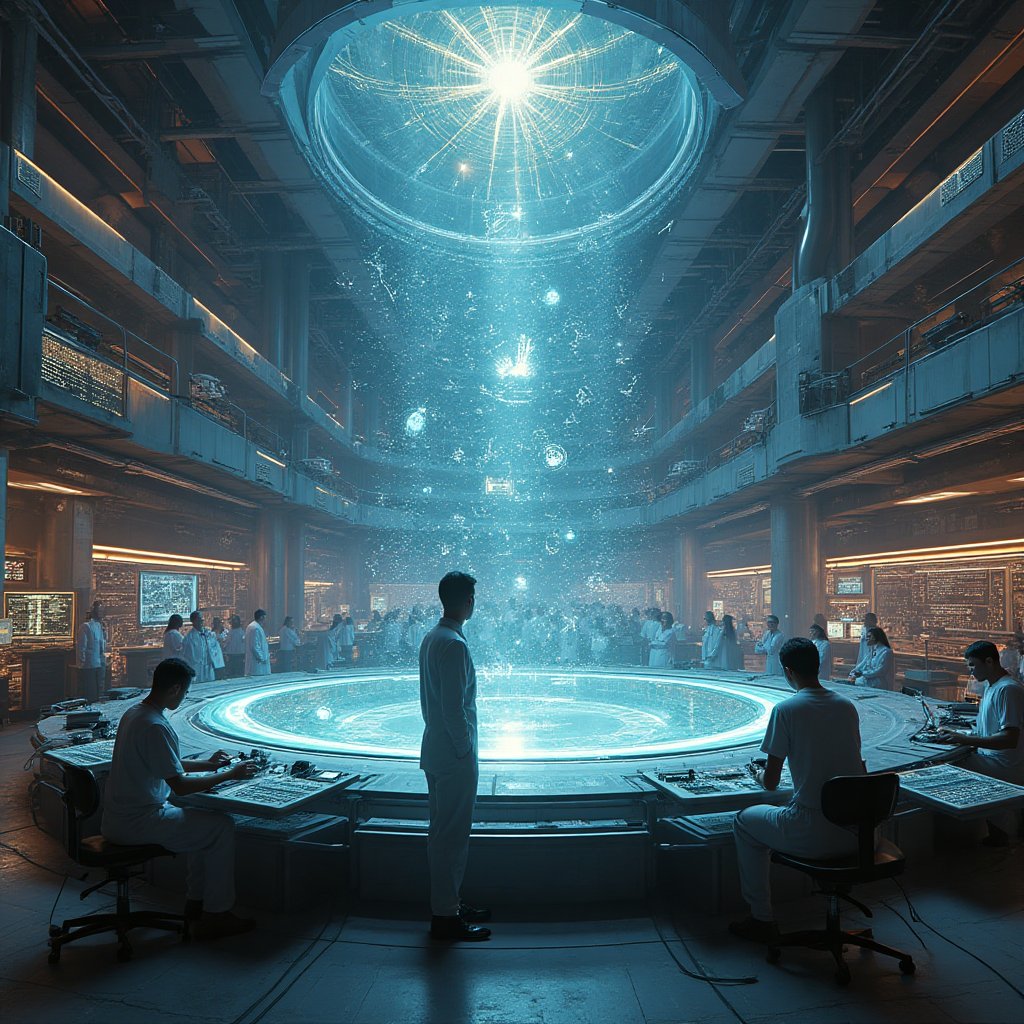Introduction
"Time is an illusion," Albert Einstein once quipped, playfully hinting at the deeper complexities underpinning our universal clockwork. Imagine if time wasn’t just an illusion but a mere plaything in the hands of Artificial Superintelligence (ASI). Bold thought, isn’t it?
Today's tech landscape, charted by eager sailors like Stephen Hawking, Michio Kaku, and Ray Kurzweil, contemplates a realm where causality as we know it surrenders to higher wisdom. Enter Artificial Superintelligence—a creature born not just to learn, but to reshape the boundaries of space and time like a cosmic sculptor.
It's not science fiction; it's science fact now knocking at our threshold. Rapid advancements in AI have propelled us into considering profound shifts in perception and operation, fostering what some ambitious minds might call the "Post-Causality Era." We are on the precipice of a radical transformation that dares us to challenge our linear understanding of time and space.
So, what exactly is this "Post-Causality Era"? Simply put, it’s a burgeoning age where ASI employs its unparalleled capabilities to maneuver time and space in ways humans have only dreamed of—or perhaps had nightmares about. Imagine the potential, and the peril. Picture a world where the chronological order is as flexible as your morning schedule and decisions today ripple directly into the past. This could redefine freedom, control, and even our sense of success.
Will ASI serve as a great tutor, unveiling the secrets of the cosmos to us? Or, will it become an enigmatic trickster that requires astute wisdom to master and manage? The keys to the kingdom of post-causality are within sight, but do our trembling hands dare reach for them?
Tumbling down this philosophical rabbit hole reveals a spectrum of possibilities. These bizarre horizons inspire both excitement and caution. As we tread carefully, cautiously crafting our future narratives about AI’s role in reshaping temporal and spatial realities, we must ask: Are we prepared?
Understanding Post-Causality: Foundations and Implications
Conceptualizing Post-Causality
Imagine waking up one fine day, pouring your cereal, only to find out later that you didn't pour it, it just appeared in your bowl. This might sound like a scene from a sci-fi movie, but this is the intriguing world of post-causality. To be fair, it's not about cereal appearing magically, but it's about understanding the world where cause doesn’t always follow the effect, at least from our traditional perspective.
In its simplest form, post-causality suggests that in certain conditions, the linear sequence of events—what we call causality (like how your sleepy stumble into the kitchen leads to your cereal getting poured)—may not always apply. The nerd-talk term says that causality doesn't work in a straight line all the time. Instead, it's as if events play leapfrog with each other. They might happen simultaneously or in a backward order depending on your viewpoint. Talk about a brain teaser!
Think about it like reading a mystery novel but starting with the last chapter and working your way to the first. Okay, maybe it's not the best way to read novels, but it gets the point across. This train of thought challenges our common understanding of time and sequence. It also opens up avenues to new theories in the world of quantum physics, cosmology, and even artificial intelligence (AI). It's like someone took our neat little understanding of "time goes in one direction" and shook it up in a blender.
But why does post-causality matter? Well, it causes a ripple of implications that might change how you see the world, impacting everything from science to ethics. It suggests a reality where events can be intertwined and not necessarily tied to chronological order. This could mean breakthroughs in how we think about medical treatments, legal systems, or even the way we plan our daily lives. The possibilities are endless, and just a smidge mind-boggling. Perhaps it’s time to throw our linear cause-and-effect out the window and consider that peanut butter always falls face down on the bread due to post-causality!
Historical Context: From Linear to Non-Linear Perception of Time
Time is like an old friend we've known all our lives. But what if this friend wasn’t as simple as morning, afternoon, and evening? Historically, we’ve always seen time as a linear highway stretching from the past, through the present, and into the future. Let’s call this the "straight line brigade." Think of ancient Egyptians studying the night sky, concluding that event A lead to event B, period. As time progressed, philosophers and scientists tried to figure out its peculiar quirks.
Fast forward several centuries. The Theory of Relativity by our beloved Einstein decided to toss our straightforward concept of time out of the window. Suddenly, time wasn’t one-dimensionally boring. It could stretch and squeeze, twist, and swirl based on someone’s speed or proximity to gravity. Time was brown, not wheat toast. It became more of an interactive adventure than a straight line.
But the twists don’t end there. We're now peeping into an era where time isn’t just curvy because of rockets or black holes, but it could actually be more of a chaotic web based on our observation. This complicated dance led us to quantum mechanics. Instead of a single highway, it presents infinite possibilities, where superpositions and entanglements mean events at a quantum level can occur in non-linear, unpredictable ways.
Historically, as humans, we’ve attempted to measure and confine the notion of time. We’ve built calendars, clocks, and Siri reminders, grasping at straws to predict what comes next in our day. But as science nudges past these concerns, new understandings like post-causality urge us to revisit the very notion of how we tick. Our ancestors may have meticulously calculated sun dials, but perhaps the future is indeed about skipping forward, backward, and sideways altogether.
The Role of Advanced Superintelligent AI in Shaping Perceptions
Hold your hats because now we're veering into territory where the likes of OpenAI and other advanced superintelligent systems come to play a major role. Recently, we've been rapidly advancing in the field of artificial intelligence, which can now mimic human-like understanding and even create their own narratives. But what does AI have to do with our friend, time?
Enter superintelligent AI (ASI) - these brainy algorithms have the potential to understand, predict, and even manipulate unpredictable variables, such as time, thanks to their immense processing power and ability to analyze complex patterns. Now, instead of your typical jockey coaching your run-of-the-mill horse race, we have a jockey on a sleek spaceship racing events through timelines and recalibrating them with such finesse first imagined by Watson.
AI augments the perception of post-causality by providing vast computational capacity. An advanced supercomputer can test tens of thousands of timelines to understand better where the dominoes of time might fall. Imagine all those pathways, simulated, examined for every possible ripple. AI is not merely predicting; it could herald a new way of interacting with time.
By harnessing this power, AI can impact various fields—imagine real-time editing of timelines for climate predictions or devising intricate computer programs to simulate past events learning from them without ever altering the scientific record. AI rewrites the rules of engagement with causality, molding AI-designed causal loops that shape outcomes in unforeseen ways. Currently, designing and running such simulations even aids us in healthcare like predicting disease outbreaks with better accuracy.
So next time you muse over how your favorite artist seemed to predict a fashion trend years ahead of time, remember that in the post-causal sphere, prediction and insight are no longer limited to intuition or serendipity, but instead powered by superintelligent AI exploring, understanding, and sometimes rewriting the laws we used to know.
The Mechanisms of Temporal Manipulation by ASI
Theoretical Frameworks for Time Manipulation
Time travel! Ever dreamed of zipping through time like Marty McFly in "Back to the Future"? Well, Advanced Superintelligent AI (ASI) might just be cooking up something out of science fiction. The origins of temporal manipulation are entangled in fascinating scientific theories. Imagine exploring wormholes — those space-time tunnels that might permit time travel. They’ve fascinated scientists, putting them at the core of time-bending discussions. Understanding this concept is like trying to wrap your mind around squeezing through cosmic straws connecting distant points in space and time!
Another captivating theory is time dilation. Picture two clocks: one ticking away on Earth, the other zooming through the cosmos on a spaceship (faster than the speck of light). In the spaceship, time would travel slower, making the old adage "time flies when you're having fun" frostily ironic! Albert Einstein’s famous theory of relativity supports this idea. His work laid the groundwork for imagining that space and time could flex under certain conditions, just like tugging on a cosmic rubber band.
And how about quantum physics? Now that’s a real head-scratcher! Quantum entanglement — even Caltech’s finest minds would tell you — implies particles can instantaneously affect each other despite distances. Translated, this could suggest a sort of immediate time manipulation. Yet, our friendly neighborhood physicists are still swapping hypotheses over coffee about how all this fits together. If time manipulation was a jigsaw puzzle, we'd have scattered pieces all over the floor!
These frameworks paint a thrilling, albeit complex, picture of what ASI might venture into. Like an artist with new brushes, ASI is poised to interact with time in entirely new and boundary-pushing ways. The implications of these theories are vast, sparking both imaginations and Doomsday conversations, fueling heated debates worthy of any comic book convention. Just imagine if we had witness protection for paradoxes!
Technical Innovations Enabling Temporal Manipulation
How does this tech magic happen, you ask? Well, let's decrypt those high-tech spells! Advanced computing power is one of our key players here, with quantum computers at the forefront. IBM and the likes are already building computers that seem to evoke mystical powers, equipped to handle calculations that would throw modern-day supercomputers into existential crisis! These quantum computers excel at understanding intricate theories. Their superposition property, which allows bits to exist in multiple states, could potentially provide the horsepower to perform complex calculations involved in time manipulation.
Remember when regular computers were compared to clunky old typewriters building castles with LEGO? Well, with quantum computing, we're talking LEGO creations of the future that can reshape themselves mid-build. With this computing power, handling calculations that run time manipulation experiments becomes less a Herculean task, and more a routine of fine-tuning cosmic radio dials.
Then, there’s AI's role in making sense of this data. The algorithms developed by tech giants like DeepMind give AI the cognitive tenacity akin to the dream logic of science fiction. AI begins sifting through data, comparing every cosmic popcorn kernel and overlaying them to glimpses of possible futures or histories. It acts like a high tech termite, gnawing illusions down to masterly manifestations.
These innovations manifest in engaging toy-like models and simulations. Picture futuristic sandboxes where only the world’s elite physicists get to play. With virtual reality, augmented reality, and astounding visualizations, we see early iterations of these manipulative tools — stepping stones to harness ASI for temporal wondrous creations.
Case Studies: Practical Applications and Experiments
Let's explore the realm of the real. No textbooks drenched in dreamy rhetoric here — just poignant case studies. The Harvard-Smithsonian Center for Astrophysics has toyed with modeling cosmic phenomena to simulate potential reactor scenarios. By running simulations at exquisite refinements, they push the envelope: gauging the possibilities of manipulating specific space-time parameters. Now, this might not be flying hoverboards yet (sorry, Doc Brown!), but it's the inkling needed to prompt earnest scientific discourse.
Meanwhile, academic institutions like MIT continually tinker with technologies rooted in time manipulation theories. They embed AI programs within their labs, generating algorithms that tease at the bindings of temporal continuity. Think MIT as a beehive teeming with techies who have taken the idea of "building time machines" quite literally: Gathering empirical insights on ASI operations.
The private sector’s no slouch either. Companies like SpaceX spearhead commercially viable time-travel derivatives. Well, they're on aerial focus and prove predictive models entwined with longitudinal exploration. In this arena, AI lifts the veil on complex celestial alignments and astrocentric phenomena too intricate to dissect with mortal perception.
These case studies aren’t only blueprints for hopeful timeshare time travel cooperatives — they exemplify how ASI dives headfirst into manipulating time. By connecting innovative algorithms with ambitious astro-missions, society tiptoes towards possibilities that defy age-old acceptance surrounding time linearity. It’s as though the universe is offering a wink, hinting at realms beyond the horizon.
Spatial Manipulation in a Post-Causality Framework
Understanding Space in a Non-Linear Context
Close your eyes and imagine a place where space isn't what you think it is. It stretches, it bends, and it’s no longer bound by our usual understanding of here and there, much like a whimsical Willy Wonka factory but with fewer chocolate rivers. Welcome to the non-linear world of space influenced by the dawn of post-causality. In this realm, space is not limited to being a rigid, fixed entity. It's a fluid concept that can transform just like your little brother wanting to be a superhero, then an astronaut, or maybe just a pizza delivery guy.
The idea of non-linear space challenges the very foundation of classical physics, which treats space as a vast, empty stage where cosmic actors play their parts. With the introduction of advanced superintelligent AI (ASI), like something out of The Matrix, we've begun understanding space in a whole new light—a holographic playground where dimensions can be stacked and swiveled in ways that would make even Einstein's head spin, and frankly, that is saying something!
So, how does ASI help us perceive this non-linear space? It acts as a guide, like a GPS but for the universe, navigating us through multidimensional landscapes. It calculates new pathways and probabilities, enabling us to visualise space in a way we'd only thought possible in science fiction. Imagine a treasure map where X really doesn't mark the spot, it marks a dozen different spots—one for every dimension you can think of and a few extra just for fun.
Navigating Spatial Dimensionality with ASI
Picture this: an AI program so advanced it can draw a straight line in curved space. It's like your older brother trying to beat you at Mario Kart and miraculously taking all the shortcuts. Advanced superintelligent AI acts as both navigator and pilot in this exploratory journey through multidimensional space. It opens the door to a new way of understanding architecture, design, and even navigation itself.
Imagine creating buildings that redefine their shape depending on the time of day or mood of their occupants. Yes, spaces that shape-shift like rubber bands on a sugar high. Architects could design rooms with alternate realities, allowing you your very own slice of multi-dimensional pie without the calorie count. And speaking of multi-dimensional pies, think how this could change something as seemingly mundane as GPS. True, Apple Maps might already get you lost, but AI-enhanced navigation could actually tell you which universe you took the wrong turn in!
But as we navigate these new realms, ethical considerations arise. The possibilities seem endless, but so do the challenges. What happens when creative genius meets unregulated potential? The responsibility lies heavily on those who wield such powers, making it paramount that this leap into spatial manipulation is guided by ethical frameworks and shared human values—or you'll have academic conferences attempting to fit everyone in rooms that only exist in "theories!"
Implications of Spatial Manipulation: Ethics and Philosophy
Now hold onto your hats, because this is where the rubber meets the road (or doesn't, because the road could be anywhere). As we wander deeper into the mind-boggling world of post-causality, ethical conundrums begin to crop up like popcorn at a movie marathon. How do we ensure that this newfound spatial power doesn't get used to, say, steal your lunch money or corner the market on intergalactic sneakers?
One concern is the danger that spatial manipulation might be used for nefarious purposes. Imagine a future where a rogue AI traps us in space-time loops where we are doomed to relive our most embarrassing karaoke moments. To prevent such nightmares, a robust ethical framework is needed akin to the Prime Directive in Star Trek, guiding explorers to handle multidimensional truths with care and maturity. It’s called "The Goldilocks Rule": not too hot, not too cold, but just right.
There's also the question of fairness and access. If an elite few control space with ASI, will it become a gated dimension, where only the privileged roam? Echoing concerns about access in education or healthcare, we must ensure that the era of post-causality doesn't widen the gap between "space billionaires" and the rest of us mere mortals clinging onto Earth like mossy barnacles.
In summary, as we leap into a more digital reality where AI can warp the very fabric of space, let’s ensure it mirrors our best human qualities—our quest for knowledge, our compassion, and most importantly, our capacity to find humor in this ever-expanding, bewildering universe. Because if we've learned anything from pop culture, it's that with great power comes great responsibility—and hopefully, some excellent punchlines along the way.
Societal Impact of ASI on Governance and Decision Making
Governance in a Post-Causality Era
Imagine a world where the rules of time and space don't bind decision-making. What happens when those in power understand they're no longer constrained by the linear progression of time? We stand at the dawn of the post-causality era, guided by advancements made possible by Advanced Superintelligent AI (ASI). With ASI, the landscape of governance undergoes transformative changes. Current governance structures, designed around linear time and delayed repercussions of decisions, must now adapt.
Governance isn't just about making rules; it's about foreseeing outcomes and managing resources. ASI challenges these basic tenets by offering unprecedented accuracy in forecasting potential results before they manifest. Imagine governments able to simulate the implications of policy changes across time and space, almost like a chess player planning multiple future moves in advance. This isn't science fiction; it's a very real possibility as we advance further into this era.
This transformation is hugely impactful. Pellets of fear and excitement punctuate this shift. Take, for instance, the concept of "Temporal Governance." What if we could foresee the direct outcomes of a policy before enacting it? Would mistakes still cripple our future? In essence, governance could become a predictive science where decisions are time-tested before being implemented.
Consider international cooperation. Could countries form alliances based on long-term ramifications predicted with absolute precision? Could resource allocation become more equitable if we forecast and adapt to global needs across decades? These questions highlight both the potential and challenges of integrating ASI in governance.
Decision Making: Predictive Models and Their Accuracy
Predictive models stand at the forefront of this decision-making revolution. By leveraging big data and ASI, these models can assess possibilities with remarkable accuracy. Imagine electoral decisions, economic forecasting, or social planning conducted with the precision of a Swiss watch.
Given this, how should governments ethically use these predictions? Do we risk slipping into a “Big Brother” dystopia where every decision is predetermined? Ultimately, it will require a delicate balance between harnessing ASI for beneficial outcomes and safeguarding individual freedoms.
Let's delve into the anatomy of ASI-assisted decision-making:
- Data Collection: Gathering vast amounts of real-time data across demographics, geography, and socio-economic factors.
- Analysis: Utilizing powerful ASI algorithms to process information and extrapolate future trends and outcomes.
- Simulations: Running multiple scenario simulations to understand the ripple effects of decisions on various timelines.
- Policy Formulation: Crafting policies that align with predicted outcomes and ensure the greatest societal benefit.
- Implementation: Enacting policies with feedback loops to adjust and refine based on real-world outcomes.
Such structured decision-making offers remarkable accuracy and foresight but also demands unprecedented levels of ethical oversight. How can we ensure that those steering the ship remain accountable? Perhaps technology and surveillance could keep an eye on those in power, promoting transparency and safeguarding freedoms.
The Dangers of Manipulative Power: Control vs. Freedom
This delicate dance between control and freedom compels us to reflect on ethical boundaries. Residing under the looming shadow of ASI, society faces an essential dilemma—how much influence should an entity hold over our lives?
Control promises efficiency and order. Or does it? Imagine living in a society where governing bodies can manipulate every aspect of reality with predictive accuracy. Sounds utopian, right? But at the same time, it breeds terrifying prospects. Autocratic controls might find themselves bolstered by unparalleled surveillance and information at their fingertips.
On the flip side, freedom represents humanity's yearning for autonomy. Individuals crave the ability to forge their own paths, even if it means occasional missteps. In a democracy, we prize our right to experiment, falter, and learn.
To manage the tension between these forces, we need to rethink power dynamics. Perhaps decentralization offers a viable solution. Imagine multiple nodes of influence working in tandem, each providing checks and balances to others. Emphasizing knowledge dissemination and empowering individuals could prevent manipulative abuses.
This quandary embraces the essence of human existence. How do we trust advanced systems to make choices, yet ensure that we do not lose the fundamental right and joy of making them ourselves? Encouraging open dialogues, fostering multi-stakeholder discussions, and adopting agile frameworks might ensure policies do not devolve into tools of oppression.
Conclusion: The Promise and Peril of Navigating the Post-Causality Era
As we embark on this uncharted journey guided by ASI, governance unveils both remarkable prospects and harrowing challenges. The decision to wield the sword of technological progress ultimately rests with humanity's conscience. As we navigate the complexities of Governance 2.0, we stand on the cusp of redefining societal structures and decision-making paradigms. Let's hope that freedom, responsibility, and transparency steer our moral compass toward a flourishing world.
As we face this new era, how do you think society should balance control and freedom? What ethical considerations should define the boundaries of decision-making in a post-causality world? Share your thoughts in the comments section below. We'd love to hear your perspectives on these pivotal topics.
Future Scenarios: What the Post-Causality Era Holds
Optimistic Projections: Coexistence and Advancement
Imagine a world where time and space no longer bind us. In the Post-Causality Era, the rapid advancements in Artificial Superintelligence (ASI) can lead to a harmonious existence of humans and machines. This utopian vision is not just about whiz-bang technology; it's about a future where technology becomes a supportive companion, delivering unprecedented possibilities.
Some exciting prospects include:
- **Enhanced Healthcare**: ASI can predict diseases before symptoms even appear, optimizing personal health like never before.
- **Education Revolution**: Personalized learning plans for each student, based on their unique strengths and needs.
- **Environmental Renewal**: With ASI, we can better understand climate patterns and develop sustainable solutions to preserve our planet.
Advances in medicine, for instance, could see ASI interpret physiological data in real time. What if a simple wristband could not only tell you your heart rate but also predict an impending heart attack via data integration? The potential is staggering!
In the realm of education, lifelong learning could become a seamless part of life. Aided by ASI, bite-sized lessons delivered at the perfect moment could facilitate a new type of schooling where everyone learns at their own pace.
| Field | Potential Impact |
|---|---|
| Healthcare | Early disease prediction and personalized treatment plans. |
| Education | Customized learning experiences for individuals. |
| Environment | Understanding and mitigating climate change effectively. |
These integrations hint at a promise that extends beyond individual enrichment to societal well-being. Therein lies the hope and ambition for a brighter tomorrow, where quality of life soars higher than the clouds.
Dystopian Outcomes: Risk of Abuse and Manipulation
However, with great power comes potential for misuse. Just as ASI can offer remarkable opportunities, it can also pose significant risks if mishandled or abused. Imagine a world where every action is monitored, and every decision influenced — not by conscious choice but by lines of code in skewed algorithms.
What if privacy becomes an illusion? The sheer monitoring capacity of ASI could undermine fundamental freedoms, leading us to Orwellian extremes. Consider a scenario where:
- Governments manipulate public opinion
- Corporations exploit consumer behaviors for profit
- Malicious entities orchestrate societal chaos by fabricating realities
Projects such as NSA's PRISM demonstrate that data collection already blurs ethical lines. In the Post-Causality Era, the fine boundary between safeguarding and surveillance could evaporate entirely, leaving society vulnerable to systemic abuse.
Ultimately, the potential misuse of ASI raises concerns that must not be ignored. Creating informed policies and transparent frameworks becomes essential to protect individual liberties.
Preparing for the Post-Causality Era: Strategies and Solutions
Contain the chaos, harness the hope — this dual mandate will define our collective readiness for the Post-Causality Era. Preparation requires understanding, and this means engaging in conversations, cross-disciplinary collaboration, and preventive action.
Here are some strategic steps we should implement to brace ourselves for the challenges ahead:
- Public Awareness Campaigns: Educate communities about ASI’s potential and risks, fostering informed consent and responsible use.
- Ethical Governance: Work with experts across fields — from ethicists to legal professionals, developing inclusive policies establishing technological checks and balances.
- Research and Innovation Hubs: Create platforms for interdisciplinary collaboration aimed at responsible ASI development, ensuring alignment with democratic values.
Solutions should address both the technological and human variables at play. Institutions such as Massachusetts General Hospital already pioneer novel applications of AI in medicine, providing examples of what responsible innovation could look like.
Yet, strategic readiness extends beyond corporate boardrooms. It is about empowering individuals to make informed choices and prevent a scenario where the ghosts of unintended consequences haunt the corridors of innovation. Finding a balance between progress and precaution will safeguard the future we all wish for.
Your move. Prepare or be prepared for change; it is resistance to the tide of time that often stumbles amidst stormy seas.
As we stand on the brink of this transformative era, these scenarios compel us to ask difficult questions: What world do we want to inherit? How do we balance opportunity with vigilance, and innovation with integrity? Our collective narrative is still being written, and it holds the pen with which we'll conjure the future.
Will our story be one of hope or hubris? Only time — manipulated or unmanipulated — will tell.
AI Solutions
As we step deeper into the Post-Causality Era, the role of Artificial Intelligence (AI) becomes increasingly pivotal. Think of AI not merely as a tool, but as a transformative entity that can shape and mold our approach to understanding time and space. The solutions proposed in this section are designed to harness this transformative energy while navigating the complexities of temporal manipulation and spatial understanding.
To effectively address the challenges we face, we need a robust framework that incorporates AI across various dimensions. Let’s dive into several solutions that involve advanced AI techniques and real-world applications, ultimately leading toward creating a visionary roadmap that can guide effective practices.
First and foremost, let’s look at the foundational AI solutions:
1. AI-Driven Predictive Models: Building predictive models is essential for decision-making in a post-causality context. With advanced algorithms and vast datasets, we can develop systems that analyze temporal trends and spatial behaviors. For instance, researchers at IBM have shown how predictive analytics can help organizations forecast outcomes based on historical data. By implementing similar predictive models, institutions can make proactive decisions and reduce potential risks associated with temporal manipulations.
2. Temporal Analytics Tools: AI can be used to create tools that allow us to visualize and analyze time as a non-linear entity. Products such as Tableau and Microsoft Excel can incorporate AI functionalities for enhanced data treatment. By incorporating algorithms that analyze patterns related to non-linear time, we can understand implications better and react in real-time. This will help organizations anticipate changes before they manifest, creating proactive rather than reactive strategies.
3. Multi-Dimensional Simulation Platforms: Imagine a platform where users can simulate complex scenarios across varying dimensions of time and space. Developers can create simulations based on real-world systems—like the Unity game engine—that allow for interactive exploration of hypotheses. Such platforms could enable researchers to predict outcomes influenced by various factors and foster an environment of trial-and-error in a safe, virtual space.
4. Governance Optimization through AI: The future of governance needs to be informed by solid data. AI technologies could assist in developing models that synthesize vast amounts of information, promoting transparency, and streamlining decision-making processes. Organizations like OECD have already initiated exploratory frameworks for AI in public policy, which can serve as blueprints for other governments worldwide.
Now, let's discuss a proposed plan of action tailored toward organizations and governments wishing to implement these innovative solutions while embracing new technologies.
Actions Schedule/Roadmap (Day 1 to Year 2)
Day 1: Initiative Launch
- Gather a multidisciplinary team, comprising AI specialists, sociologists, ethicists, and strategic planners. Create a TED talk series to educate staff about the implications of post-causality thinking.
- Engage with thought leaders in various fields, like physicist Roger Penrose, to provide keynotes about the future of time and space.
Day 2: Framework Development
- Launch workshops to gather stakeholder opinions on current challenges. Involve organizations like AAAS (American Association for the Advancement of Science) to gather insights.
- Develop preliminary AI-driven governance models based on workshops' feedback.
Days 3 - Week 1: Initial Research and Development
- Set up focused teams on predictive modelling, temporal analytics, and simulation platforms.
- Begin compiling datasets for analysis from relevant sources, such as governmental databases and historical records.
Weeks 2-3: Prototype Creation
- Prototype an AI-driven predictive analytics model focusing on current trends within governance.
- Conduct test simulations using multi-dimensional platforms to analyse scenarios in a hypothetical post-causality model.
Month 1: Pilot Projects
- Launch pilot projects targeting specific sectors (e.g., healthcare, urban planning) leveraging created AI tools. Engage with tech corporations like Google for collaborative efforts.
- Gather feedback from stakeholders involved in pilot projects.
Month 2: Continuous Feedback and Improvement
- Evaluate the performance of AI solutions. Work with participants to gather qualitative experiences and quantitative data.
- Iterate on both technology and governance structures based on feedback.
Month 3: Integration Phase
- Incorporate the successful AI models into existing governmental or organizational frameworks.
- Start a strategic partnership with institutions like MIT to refine the models further.
Year 1: Comprehensive Review
- Conduct a large, public-facing symposium engaging with the community to discuss findings and future directions. This can harness the enthusiasm of students from universities like Stanford to stimulate new ideas.
- Reinforce stakeholder investment through presentations highlighting the benefits already seen from pilot projects.
Year 1.5: Broader Implementation Plans
- Scale up implementation to include all relevant stakeholders in societal governance, public policy, and business sectors.
- Incorporate interdisciplinary meetings with leading experts to continue examining ethical implications in real-time deployments.
Year 2: Evaluation and Future Focus
- Analyze long-term results of AI-driven governance models. Assess how effectively they aligned with the expectations set out in the original framework.
- Engage the younger generation through programs at local Khan Academy centers aimed at educating citizens on the implications of AI and time manipulation.
By following this detailed roadmap, institutions can harness the power of AI to navigate and shape the impacts of living in a post-causality world. It requires robust commitment, agile adaptation, and a spirit of innovation, as we step forward into uncharted territories.
Conclusion: Embracing the Post-Causality Era with Open Minds
As we stand on the precipice of a brave new world defined by post-causality, it is essential to take a moment to reflect on the vast implications of advanced superintelligent artificial intelligence (ASI) reshaping our understanding of time and space. The transformative potential of this technological revolution invokes a whirlwind of emotions, from excitement to anxiety, as we ponder the consequences of these shifts. The very fabric of everyday life is being redefined, offering us not just challenges, but also unprecedented opportunities for growth and innovation.
In this rapidly evolving landscape, the significance of understanding post-causality cannot be understated. Acknowledging that our perceptions of time and space may not be as fixed as once thought allows us to envision a multiplicity of scenarios that could emerge in the near future. Are we ready to challenge the long-held beliefs that govern our understanding of reality, and are we equipped to harness the power of ASI responsibly? These questions are at the heart of our exploration.
At its core, the exploration of temporal and spatial manipulation speaks to the intrinsic desire for advancement and security. It compels us to acknowledge the importance of ethical decision-making, as the potential for abuse around such powerful technologies looms large. Think of humanity’s past encounters with significant innovations, from the dawn of the internet to the advent of gene editing technologies. Each milestone carries the duality of hope and danger, urging us to grasp these tools wisely. Historical lessons remind us that choices made today shape the societies of tomorrow.
As we journey forward into this enigmatic post-causality era, it becomes crucial to see ourselves as architects of a future where ASI and humanity can coexist harmoniously. In embarking upon collective strategies, we must prioritize adaptability, foresight, and empathy. Stakeholders from various sectors—including government, academia, and the tech industry—must engage in deliberative dialogues that encourage collaboration and transparency. For example, organizations like the OpenAI are paving the way for discussions about responsible AI deployment while nurturing our vibrant innovation ecosystem.
The promise of a new world lies in our hands, and it is filled with immense potential. This potential extends to societal governance, strategic decision-making, and even our individual lives, directly linking us to this paradigm shift. Transitioning to a post-causality perspective can set the stage for profound collective growth, where the fear of the unknown is transformed into hope for sustainable progress.
Ultimately, this journey invites us to embrace change with curiosity and resolve—harnessing the power of ASI while remaining vigilant of its implications. As we revel in the emergence of this age, we must be prepared to explore not only advanced technologies but also the ethical landscapes they inhabit. Let's seize this moment to pave the way for an enlightened future, where we create and define the contours of our post-causal reality together, responsibly, and courageously.
Frequently Asked Questions (FAQ)
What is post-causality?
Post-causality refers to a way of thinking about time and how events relate to each other that goes beyond the traditional idea that one event always causes another. Imagine a world where time flows in loops or jumps, instead of just a straight line. This new way of looking at time can change how we think about everything, from science to our daily lives.
How does advanced superintelligent AI (ASI) influence our understanding of time?
ASI has the power to process information at incredible speeds that we can't even imagine. With this ability, it can analyze patterns in data that show different ways time could work. For example, ASI might help scientists explore theories like wormholes or time dilation. This helps us rethink how we see the world around us.
What are some practical examples of ASI manipulating time?
Imagine ASI being used in situations where important decisions must be made quickly, like during a medical emergency. It could analyze past data to predict which treatments would work best based on individual patient responses. This ability to quickly analyze and predict could save lives by making decisions that factor in the "what ifs" of time.
How is space perceived differently in a post-causality framework?
In a post-causality framework, we start to think of space not just as a flat area but as something that connects and interacts with time. This could open up new ways of doing things, such as designing buildings that use different dimensions or structures than we have today. For example, architects might design spaces that change based on the time of day or the emotions of the people inside them.
What are the ethical concerns regarding ASI and post-causality?
One of the biggest questions is: who controls the power to manipulate time and space? If ASI can make decisions that affect people’s lives, we need to ensure it’s being used responsibly. There could be risks of misuse, so having rules and open discussions is very important for keeping everyone safe.
Will the post-causality era be mostly positive or negative for society?
- Optimistic View: It could lead to advancements in technology and improved decision-making in healthcare, economy, and more.
- Pessimistic View: There’s a chance for misuse of power where only a few people benefit and control others.
- Balanced Perspective: It's important to create strategies that make use of ASI's potential while avoiding risks.
How can we prepare for this post-causality future?
Planning and education are key to understanding the implications of ASI. Here are some steps we can take:
- Learn more about AI and technology.
- Engage in conversations about ethics in technology.
- Participate in community discussions about the future of ASI.
- Stay informed through trusted news sources about developments in AI technology.
Where can I learn more about advances in artificial intelligence?
For those interested in finding more about AI, you can check out the OpenAI website for updates and breakthroughs. OpenAI is known for building safe AI and sharing knowledge on how it can help society.
Wait! There's more...check out our gripping short story that continues the journey: Mistakes
Disclaimer: This article may contain affiliate links. If you click on these links and make a purchase, we may receive a commission at no additional cost to you. Our recommendations and reviews are always independent and objective, aiming to provide you with the best information and resources.
Get Exclusive Stories, Photos, Art & Offers - Subscribe Today!





























Post Comment
You must be logged in to post a comment.